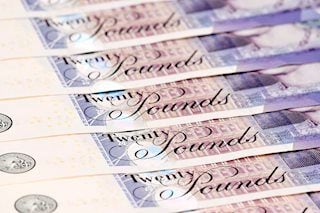GBP/USD Price Analysis: Bullish potential seems intact while above 1.2900 mark
|
- GBP/USD lacks firm intraday direction and oscillates in a narrow range on Tuesday.
- The fundamental backdrop and the technical setup seem tilted in favor of bulls.
- A convincing break below the 1.2900 mark is needed to negative the positive bias.
The GBP/USD pair struggles to capitalize on the previous day's modest bounce from the 1.2900 neighborhood and oscillates in a narrow trading band during the Asian session on Tuesday. Spot prices currently hover around the 1.2930 area, nearly unchanged for the day, and remain at the mercy of the US Dollar (USD) price dynamics.
Investors have fully priced in an interest rate cut by the Federal Reserve (Fed) at the September policy meeting, which keeps the US Treasury bond yields depressed. This, in turn, prompts some USD selling and turns out to be a key factor acting as a tailwind for the GBP/USD pair. Apart from this, the diminishing odds of an interest rate cut by the Bank of England (BoE) in August offer some support to the currency pair.
From a technical perspective, the recent breakout through the previous YTD peak, around the 1.2895 region, was seen as a fresh trigger for bullish traders. Moreover, the Relative Strength Index (RSI) on the daily chart has eased from the overbought zone and is holding comfortably in positive territory. This validates the positive outlook and suggests that the path of least resistance for the GBP/USD pair is to the upside.
Some follow-through strength beyond the 1.2960-1.2965 immediate hurdle will reaffirm the constructive setup and allow bulls to reclaim the 1.3000 psychological mark. The subsequent move-up has the potential to lift the GBP/USD pair back towards the YTD peak, around the 1.3045 area touched last week. The momentum could extend further towards the 1.3100 mark en route to the July 2023 swing high, around 1.3140 region.
On the flip side, bearish traders need to wait for a sustained break and acceptance below the 1.2900 round-figure mark before placing fresh bets. The said handle should now act as a key pivotal point, below which the GBP/USD pair could decline further towards intermediate support near the 1.2855 zone before eventually dropping to the 1.2820-1.2815 region and the 1.2800 round-figure mark.
GBP/USD daily chart
Pound Sterling FAQs
The Pound Sterling (GBP) is the oldest currency in the world (886 AD) and the official currency of the United Kingdom. It is the fourth most traded unit for foreign exchange (FX) in the world, accounting for 12% of all transactions, averaging $630 billion a day, according to 2022 data. Its key trading pairs are GBP/USD, aka ‘Cable’, which accounts for 11% of FX, GBP/JPY, or the ‘Dragon’ as it is known by traders (3%), and EUR/GBP (2%). The Pound Sterling is issued by the Bank of England (BoE).
The single most important factor influencing the value of the Pound Sterling is monetary policy decided by the Bank of England. The BoE bases its decisions on whether it has achieved its primary goal of “price stability” – a steady inflation rate of around 2%. Its primary tool for achieving this is the adjustment of interest rates. When inflation is too high, the BoE will try to rein it in by raising interest rates, making it more expensive for people and businesses to access credit. This is generally positive for GBP, as higher interest rates make the UK a more attractive place for global investors to park their money. When inflation falls too low it is a sign economic growth is slowing. In this scenario, the BoE will consider lowering interest rates to cheapen credit so businesses will borrow more to invest in growth-generating projects.
Data releases gauge the health of the economy and can impact the value of the Pound Sterling. Indicators such as GDP, Manufacturing and Services PMIs, and employment can all influence the direction of the GBP. A strong economy is good for Sterling. Not only does it attract more foreign investment but it may encourage the BoE to put up interest rates, which will directly strengthen GBP. Otherwise, if economic data is weak, the Pound Sterling is likely to fall.
Another significant data release for the Pound Sterling is the Trade Balance. This indicator measures the difference between what a country earns from its exports and what it spends on imports over a given period. If a country produces highly sought-after exports, its currency will benefit purely from the extra demand created from foreign buyers seeking to purchase these goods. Therefore, a positive net Trade Balance strengthens a currency and vice versa for a negative balance.
Information on these pages contains forward-looking statements that involve risks and uncertainties. Markets and instruments profiled on this page are for informational purposes only and should not in any way come across as a recommendation to buy or sell in these assets. You should do your own thorough research before making any investment decisions. FXStreet does not in any way guarantee that this information is free from mistakes, errors, or material misstatements. It also does not guarantee that this information is of a timely nature. Investing in Open Markets involves a great deal of risk, including the loss of all or a portion of your investment, as well as emotional distress. All risks, losses and costs associated with investing, including total loss of principal, are your responsibility. The views and opinions expressed in this article are those of the authors and do not necessarily reflect the official policy or position of FXStreet nor its advertisers.
